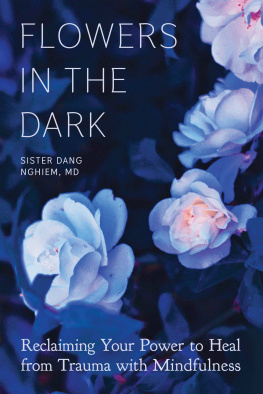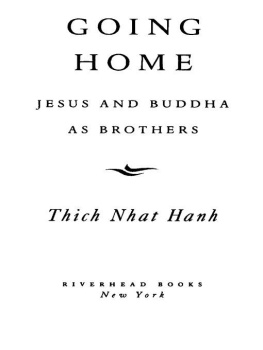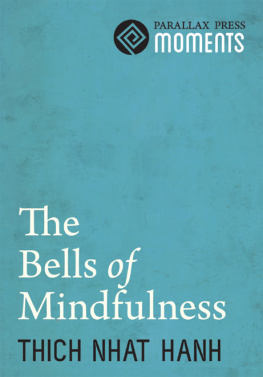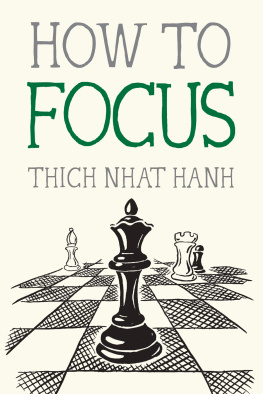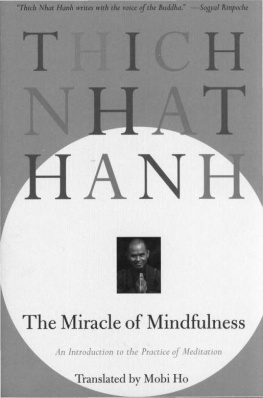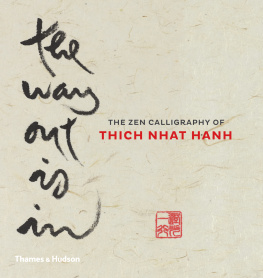

In dedication to our Beloved Teacher
and his faithful transmission
of the Dharma through his life and practice.
In gratitude to Dr. Horowitz, Dr. Quang,
Gene Kira, Sister The Nghiem, Sister Truc Nghiem,
monastic and lay brothers and sisters.
To Sunee, the joyful manifestation
of my Mother, and my brother Sonny.
Each moment you live deeply is a love story.
CONTENTS
For seven years I lived in Deer Park Monastery in California, where we have many types of grand oak trees. Some oak trees have curved trunks and stretched out branches like graceful dancers. Some oak trees stand tall and upright with wide branches.
Wherever there are oak trees, there are also rocks and boulders. Over the years, an oak would grow over the rock and into the rock, and the rock would become a part of the oak and vice versa. If you ever see an oak tree that has fallen over, you will see that its deep roots are woven to rocks and gigantic boulders from underneath the surface of the earth. Rock and oak, they are two, but they have become one. They support each other. The rock offers the stability and the minerals to the oak, and the oak stands tall but deeply rooted in the earth and in the rock. This relationship between the oak and the rock is powerfully moving to me, and I believe that in true love we should be this to each other, that we should grow into each other over time. There is no longer the separation between you and me even though the oak has its own character and the rock has its own character. They live together in deep harmony and support. The oak can be oak because of the rock, and the rock can be rock because of the oak.
As spiritual beings together on a joyful path, we also learn to grow in our love, our transformation, and our healing in the spirit of the oak and the rock. Your happiness is my happiness, and your suffering is my suffering. Taking care of me is taking care of you, and taking care of you is taking care of me.
Few books talk about love for oneself. All of us want to love and to be loved, but we often direct this energy outward, focusing our love on a person or an object outside of ourselves. When we direct love outward in this way, we neglect the love that goes inward. Love becomes an idea of self vis-a-vis other. It manifests a behavior of grasping, holding onto something to make it yours, in order to assure your chance of survival or to reinforce your sense of self.
What I have been going through in my life teaches me that love first and foremost must be turned inwardly. It must first be directed toward oneself.
As a young woman growing up, I always felt that if I had a successful career, if I became somebody, and if I found my soul mate, then my life would be complete; all the losses and abuse I had experienced in my childhood would be compensated for.
I attained all of that. I went to medical school, had a successful career, and was young and beautiful with many people to pursue and many people pursuing me. I was also in romantic relationships. I had a partner who loved me absolutelyand yet I was always ready to turn my back on him every time the suffering of the past arose. I would befriend and cling to my suffering instead of cherishing the conditions of happiness available to me. I would look for love from the outside and I was never satisfied. Even if the Buddha came and loved me, I might still walk away because I didnt know how to love myself.
Often we think of a soul mate as a person outside of us who knows us well. In Vietnamese, the word soul mate is tri ky. Tri means, to know, to remember, to master. Ky means oneself. So a soul mate is one who knows, remembers, and masters oneself. As the word tri ky implies, its important to remember that the true lovethe soul mate were always seekingis already always present inside of us. If we know, remember, and master ourselves, we discover who we are, what the meaning of life is, and what we should be doing here on this planet Earth.
How can we learn this true love, to know, remember, and master ourselves? We can only master something if we know what it is and practice it often. In Chinese, the character mindfulness literally means now mind and it also means to remember. Mindfulness has become a buzzword and a fashion nowadays. However, mindfulness in its true essence is an inherent human capacity. Daily mindfulness practice and cultivation strengthen this capacity to anchor the mind in the present moment, so that it can remember, know, and take appropriate care of the body, feelings, thoughts, and perceptions.
The Buddha used the image of the moon to describe the gentle, discreet, but ever-embracing quality of mindfulness. When the moon rises in the sky, it rises so quietly that its unnoticeable. Most of us are not aware that the moon is rising. Even when the moon is already up there in the middle of the sky, most of us are still unaware of it. Yet when the moon is still at the horizon, it already starts to spread its soft gentle light and brighten the surroundings. As it ascends higher, the moons light spreads farther and farther to the bamboo groves, to the forest, and to every small corner. Every part of life is being shined upon by the moon and is reflecting the moonlight.
This gentle, discreet, but ever-embracing quality of moonlight can be seen in mindfulness. Mindfulness is something soft, quiet, gentle, and discreet, but nevertheless it has the capacity to embrace all aspects of our life. It imbues every pore of our skin and every part of our being. When were aware of our breathing, our steps, or a drop of dew that is hanging from the tip of a leaf, that awareness is gentle and soft like the moonlight. Yet its ever penetrating and it brings a certain quality of brightness and lightness to us. We feel connected to that dewdrop, to that leaf, to that in-breath and out-breath, and to every aspect of our life. Quietly and slowly, we feel connected to life itself.
Thus, mindfulness practice has enabled me to cultivate and offer love to myself so that I will have something to offer to others, and so that when others offer love to me, I dont reject it out of fear or grasp it out of loneliness. Love shouldnt be from neediness or grasping, but from mutuality, understanding, acceptance, and trust that we offer to one another. Only then can love be true; only then can one have something meaningful, substantial, and real to offer to oneself and to others.
Were fortunate that the Buddha gave us four concrete teachings about the components of true love, which he referred to as the Four Immeasurable Minds of love, and which my Teacher, Zen Master Thich Nhat Hanh, also refers to as the elements of true love. These are four capacities and qualities that are innate in each of us. Through our mindfulness practice, we can cultivate and fully realize them.
The first of the Buddhas Four Immeasurable Minds of love is maitri
Next page

